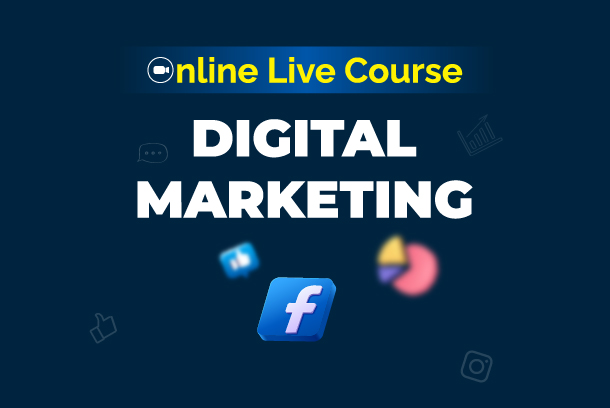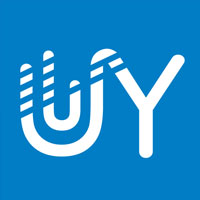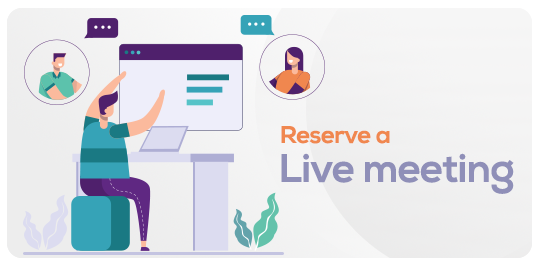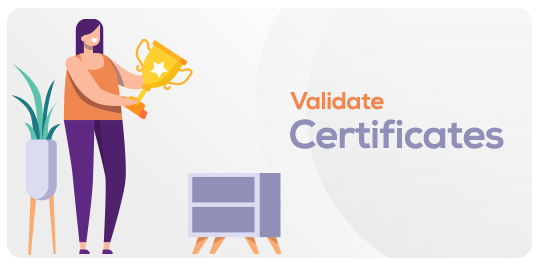Advanced Digital Marketing - Online Course
in ONLINE LIVE COURSESWhat you will learn?
Social Media Optimization
Facebook Marketing Fundamentals
Google Ads Campaign Creation and Optimization
YouTube seo
About this course
Welcome to Digital Marketing Online Course by UY Lab.
Professions that are going to be the demand of the generation, Digital Marketing is one of them. The strategies & techniques require for this sector, makes it one the most challenging & fascinating career options. From this course you’ll be the master of ads, strategies, optimizations & so on. Also, this course will be the stepping stone towards your freelancing career. Here’s a summary below what you’re going to learn in this course:
- Digital Marketing Strategy
- Social Media Optimization
- Secret Methods of Generating Organic Traffic on Social Media
- Social Media Marketing
- Setting Up Facebook Business Manager, Ad Manager
- Facebook Advertising Strategy from Basic to Advance
- Facebook Pixel Set up, Easy and Simple Method
- How to create Facebook Ads Campaign, Ads Set, Ads Copy
- Facebook Ads Live Campaign
- Facebook Analytics, Reporting, and Optimization
- Email Marketing
- Live Email Campaign Set up
- Search Engine Marketing
- Setting Up Google Ads Campaign
- YouTube Marketing (Video Marketing)
Working Areas
- Fiverr
- Remote Job
- Local & personal projects
To ease the learning process of our students we provide class recordings with necessary materials for practicing. But before proceeding to next recording, a trainee should must complete assignments of previous class. Instructor will approve & evaluate the assignments.
Contact us for any support/query: 01783-838382 | support@uylab.org
Requirements
Access to computer or laptop
Stable internet connection
Curiosity & dedication
FAQ
Comments (0)
#Understanding the basics of digital marketing
Digital marketing involves promoting products or services using online channels like social media, SEO, email, and content to reach and engage a targeted audience.
# Importance of a well-defined digital marketing strategy
A well-defined digital marketing strategy aligns efforts, targets specific audiences, and optimizes resources, enhancing brand visibility, engagement, and conversions for business success in the competitive online landscape.
#Overview of key digital marketing channels
Key digital marketing channels include social media platforms for engagement, search engines for visibility, email marketing for direct communication, and content creation to provide value, collectively driving brand awareness and customer interaction.
#Importance of audience segmentation
Audience segmentation tailors marketing efforts to specific demographics, enhancing relevancy and engagement, leading to higher conversion rates, improved customer satisfaction, and more effective resource utilization.
#Different segmentation criteria and techniques
Segmentation criteria include demographic (age, gender), geographic (location), psychographic (lifestyle), and behavioral (purchase history), guiding marketers to employ techniques like surveys, data analysis, and CRM insights for targeted campaigns and personalized customer experiences.
# Targeting strategies for better engagement and conversion
Implement targeting strategies such as behavior-based retargeting, lookalike audience targeting, and segmentation by interests to enhance engagement and conversions by reaching the most relevant and interested audience segments.
#What is Social Media Optimization (SMO)?
Social Media Optimization (SMO) refers to the process of enhancing a brand's online presence and visibility on social media platforms by optimizing content, engaging with the audience, and utilizing strategies to increase reach, interactions, and overall engagement.
#Optimizing social media profiles for brand consistency
Optimize social media profiles by using consistent brand imagery, messaging, and tone across all platforms, ensuring clear logo usage, coherent color schemes, and cohesive content themes to reinforce brand identity and recognition.
#Strategies to increase reach and engagement on social platforms
Increase reach and engagement on social platforms through consistent posting schedules, interactive content like polls and questions, utilizing relevant hashtags, collaborating with influencers, hosting contests, leveraging user-generated content, and analyzing metrics to refine strategies for maximum impact.
#Overview of Facebook as a marketing platform
Facebook is a powerful marketing platform offering targeted advertising, business pages for brand visibility, audience engagement through posts and live videos, messenger marketing for direct communication, and in-depth analytics, enabling businesses to connect with a global audience and drive conversions effectively.
#Benefits of using Facebook for business promotion
Using Facebook for business promotion offers benefits like broad audience reach, targeted advertising options, cost-effective campaigns, real-time engagement, customer feedback, detailed insights through analytics, and the ability to build a loyal community, ultimately driving brand awareness and growth.
#Introduction to Facebook Page and Ad Manager
A Facebook Page is a business profile on the platform that allows organizations to connect with users, share content, and engage with their audience. Facebook Ad Manager is a tool that facilitates the creation, management, and optimization of paid advertising campaigns on Facebook, providing targeting options, ad placements, budget control, and performance tracking for effective marketing efforts.
#Creating and Optimizing Facebook Pages for Business
Efficiently craft and enhance Facebook business pages for optimal results.
#Setting up a professional Facebook Page
Establish a polished Facebook business page by meticulously filling out all relevant information, selecting compelling visuals, and integrating useful features for a professional online presence.
#Optimizing page elements for better visibility
Enhance visibility by refining content, utilizing strategic keywords, and engaging with the audience consistently on your Facebook Page.
#Utilizing features to enhance user experience
Elevate user experience on your Facebook Page through interactive posts, responsive messaging, and seamless integration of multimedia for a dynamic online interaction.
#Navigating the Facebook Ad Manager interface
In Facebook Ad Manager, access the navigation menu on the left to create, manage, and monitor ad campaigns. Use the tabs to navigate through Campaigns, Ad Sets, and Ads, adjusting settings and monitoring performance for effective advertising.
#Creating and managing ad campaigns
Craft and launch ad campaigns in Facebook Ad Manager by defining objectives, targeting the audience, setting budgets, and designing compelling ad creatives. Monitor campaign performance, adjust settings, and optimize based on insights for successful management.
#Overview of ad targeting options and objectives
Facebook offers diverse ad targeting, including demographics, interests, behaviors, and lookalike audiences, maximizing reach. Objectives encompass awareness, consideration, and conversion goals, allowing tailored campaigns for brand building, engagement, or driving specific actions.
#Gathering insights about your target audience
Collect valuable insights about your target audience through data analysis, social media monitoring, surveys, and analytics tools to refine your strategies and deliver more relevant content.
#Tools and techniques for audience research
Utilize tools like social media analytics, Google Analytics, and audience insights on platforms, along with techniques such as surveys, interviews, competitor analysis, and keyword research to comprehensively research and understand your target audience.
#Using data to refine your marketing strategies
Leverage gathered data to iteratively refine marketing strategies by identifying trends, optimizing audience targeting, adjusting content approaches, and allocating resources more effectively for improved campaign outcomes.
#Step-by-step guide to creating a successful Facebook campaign
Define objectives, target audience, design compelling content, set budget, and monitor performance for a triumphant Facebook campaign.
#Ad creative best practices
Craft impactful ad creatives by focusing on clear messaging, captivating visuals, concise copy, strong call-to-action, and ensuring mobile responsiveness for optimal engagement.
#Monitoring and measuring campaign performance
Continuously monitor and measure campaign performance by tracking key metrics, analyzing data trends, comparing against goals, and adjusting strategies based on insights for ongoing improvement.
#Implementing Retargeting Ads for Better Results
Enhance results with retargeting ads by targeting users who previously interacted with your site, adjusting messaging to their behavior, and strategically positioning ads to re-engage and convert interested audiences.
#What is retargeting and why it's important
Retargeting, also known as remarketing, involves showing ads to users who have previously interacted with your website or content. It's crucial because it re-engages potential customers who've shown interest, reinforcing brand familiarity, increasing conversion chances, and boosting overall ad effectiveness.
#Setting up retargeting campaigns on Facebook
To set up retargeting campaigns on Facebook, create a Custom Audience by uploading customer lists, installing the Facebook Pixel on your website, or utilizing engagement data. Then design tailored ads to reconnect with these audiences and encourage desired actions for more effective conversions.
#Strategies to engage and convert retargeted audience
Engage and convert retargeted audiences by delivering personalized content, offering exclusive promotions, highlighting product benefits, utilizing dynamic ads, and employing urgency tactics to encourage action and capitalize on their prior interest.
#Elements of a persuasive ad copy
A persuasive ad copy comprises a compelling headline, relatable storytelling, clear value proposition, addressing pain points, social proof, strong call-to-action, and a sense of urgency, all tailored to resonate with the target audience and drive desired actions.
#Crafting attention-grabbing headlines and descriptions
Craft attention-grabbing headlines with curiosity, strong verbs, and relevance. Complement with concise descriptions that highlight benefits, solutions, and emotions to captivate and compel users to read more or take action.
#A/B testing ad copy for optimal results
Enhance results through A/B testing ad copy by creating variations with different headlines, descriptions, or calls-to-action, then randomly exposing them to segments of your audience to determine which version performs better, guiding you to refine and optimize your ad content.
#Campaign Optimization Strategies for Improved Performance
Boost campaign performance with optimization strategies including regular data analysis, adjusting targeting parameters, refining ad creatives, experimenting with different formats, and reallocating budgets based on insights to maximize ROI and achieve better results.
#Continuous improvement of ad campaigns
Achieve continuous improvement in ad campaigns by analyzing metrics, identifying trends, adapting strategies, testing new elements, learning from successes and failures, and staying updated with industry trends to refine and evolve your campaigns over time.
#Monitoring key performance metrics
Monitor key performance metrics such as click-through rate (CTR), conversion rate, cost per conversion, ad relevance score, and return on ad spend (ROAS) to assess the effectiveness of your campaigns and make informed adjustments for optimal results.
#Implementing adjustments based on data analysis
Implement adjustments based on data analysis by identifying underperforming areas, optimizing targeting, refining ad elements, reallocating budgets, and aligning strategies with insights to enhance campaign performance and achieve desired outcomes.
#Introduction to Facebook Pixel and its importance
The Facebook Pixel is a code snippet you place on your website, enabling you to track user interactions, gather valuable data on user behavior, and measure conversions. Its importance lies in providing insights to optimize ad targeting, refine campaigns, and accurately attribute conversions, ultimately improving your advertising effectiveness and ROI.
#Step-by-step guide to installing the Pixel
To install the Facebook Pixel, access Events Manager, create a Pixel, copy the generated code, and paste it into your website's header, allowing you to start tracking user actions and conversions.
#Tracking and leveraging user behavior data
Track and leverage user behavior data to understand preferences, tailor content, refine targeting, and optimize campaigns for more relevant and engaging interactions.
#Social Graphic Design using Canva
Create compelling social graphics using Canva by selecting a template, customizing visuals and text, incorporating branding elements, and exporting the final design for impactful social media posts.
#Overview of Canva for creating visuals
Canva is a user-friendly graphic design tool that offers a wide range of templates, images, fonts, and elements for creating visually appealing graphics. Users can easily customize designs, add text, upload images, and export their creations for various purposes like social media posts, presentations, and marketing materials.
#Design principles for effective social media graphics
Design effective social media graphics by adhering to principles like visual hierarchy, simplicity, consistency with branding, appropriate color palettes, legible typography, balanced composition, and using high-quality imagery to enhance engagement and convey your message seamlessly.
#Hands-on tutorials for designing different types of visuals
Explore hands-on tutorials for designing various visuals using tools like Canva, including creating eye-catching social media posts, designing engaging infographics, crafting attention-grabbing banners, producing informative presentations, and designing appealing logos for comprehensive graphic design skills.
#Instagram as a visual marketing platform
Instagram is a powerful visual marketing platform that allows businesses to showcase products, tell stories, and connect with audiences through captivating images and videos. Utilize features like Stories, Reels, IGTV, and Carousel posts to engage users, strengthen brand identity, and drive conversions in a visually-driven environment.
#Optimizing profile and bio for brand identity
Optimize your profile and bio for brand identity on Instagram by using a recognizable profile picture, aligning with brand colors and aesthetics, crafting a concise and compelling bio that highlights your value proposition and includes relevant keywords, and incorporating relevant hashtags and contact information to enhance discoverability and engagement.
#Content strategies for Instagram posts and Stories
For Instagram posts, employ a mix of product showcases, behind-the-scenes glimpses, user-generated content, educational posts, and inspirational visuals that resonate with your target audience. In Stories, leverage interactive features like polls, questions, and countdowns, along with a combination of behind-the-scenes content, promotions, and storytelling to create engaging and diverse content that keeps users coming back.
#Understanding LinkedIn's professional audience
LinkedIn's professional audience comprises individuals from various industries seeking to network, share industry insights, showcase expertise, and explore career opportunities. It's a platform where users engage with professional content, connect with peers, and build relationships to enhance their career growth and business prospects.
#Crafting an effective LinkedIn company page
Craft an effective LinkedIn company page by including a professional logo and cover image, writing a concise and engaging company description, showcasing key products/services, sharing relevant industry content, leveraging employee advocacy, utilizing rich media (videos, images, articles), and encouraging engagement through thought-provoking posts and interactions.
#Strategies for B2B marketing on LinkedIn
Leverage LinkedIn for B2B marketing by sharing industry insights, thought leadership content, and case studies, while utilizing targeted advertising to engage professionals and nurture leads effectively.
#Overview of Google Ads and its benefits
Google Ads is a powerful online advertising platform that lets businesses create and display ads across Google's vast network, reaching potential customers when they search for products/services, browse websites, or use apps. Its benefits include targeted reach, measurable results, various ad formats, control over budgets, and the ability to adjust campaigns in real-time for optimized ROI.
#Setting up a Google Ads account
To set up a Google Ads account, visit the Google Ads website, click "Start Now," choose your campaign goals, set your targeting preferences, create your ad groups with keywords and ad copy, set your budget, and launch your campaigns to start reaching your desired audience with targeted ads.
#Exploring different campaign types and goals
Explore diverse Google Ads campaign types like Search, Display, Video, Shopping, and App campaigns, each with specific goals: Search for driving website traffic, Display for brand exposure, Video for engagement, Shopping for online product visibility, and App campaigns for app installs and engagement, tailoring your approach to your business objectives.
#Creating targeted Google Ads campaigns
Create targeted Google Ads campaigns by defining specific audience demographics, selecting relevant keywords, crafting compelling ad copy, setting bid strategies, and utilizing ad extensions to effectively reach your intended audience and achieve your campaign goals.
#Keyword research and selection strategies
Conduct comprehensive keyword research using tools like Google Keyword Planner and SEMrush, focusing on relevant industry terms, long-tail keywords, and competitor analysis. Prioritize keywords with high search volume, low competition, and alignment with your offerings to maximize campaign relevance and potential for conversions.
#Ad bidding, budgeting, and tracking conversions
Conduct comprehensive keyword research using tools like Google Keyword Planner and SEMrush, focusing on relevant industry terms, long-tail keywords, and competitor analysis. Prioritize keywords with high search volume, low competition, and alignment with your offerings to maximize campaign relevance and potential for conversions.
#Display ad
Display ads are visual advertisements shown on websites within Google's Display Network. They include various formats like banners, images, videos, and interactive ads, allowing businesses to showcase their offerings to a wider audience while targeting specific demographics, interests, and behaviors, increasing brand visibility and potential conversions.
#Video ad
Video ads are engaging visual advertisements displayed on platforms like YouTube and across the Google Display Network. They can take the form of in-stream ads before, during, or after videos, or as video discovery ads alongside search results. Video ads are a compelling way to deliver messages, showcase products, and connect with audiences through dynamic storytelling.
#YouTube as a powerful video marketing platform
YouTube is a potent video marketing platform offering a vast audience base, allowing businesses to share video content, tutorials, product demonstrations, and branded stories. With features like pre-roll, mid-roll, and post-roll ads, YouTube enables precise targeting and engagement, making it a prime platform to connect with audiences visually and establish a strong online presence.
#Creating a YouTube channel for business
Establish a YouTube channel for your business by selecting a clear and relevant channel name, creating a compelling channel art and logo, writing a concise and engaging channel description, organizing playlists for easy navigation, and consistently uploading high-quality videos that align with your brand and cater to your target audience's interests.
#Video optimization, promotion, and engagement strategies
Optimize videos by using relevant keywords in titles, descriptions, and tags, creating captivating thumbnails, and adding closed captions for accessibility. Promote videos through social media, email newsletters, and collaborations. Engage with viewers by responding to comments, encouraging likes and subscriptions, and using interactive elements like end screens and cards to keep viewers engaged and encourage further actions.
#YouTube optimization
Optimize YouTube presence by creating keyword-rich video titles and descriptions, compelling thumbnails, relevant tags, and accurate closed captions. Consistently upload high-quality content, engage with the audience through comments, likes, and shares, and analyze metrics to refine strategies and enhance overall video performance.
#Marketplaces for Business Opportunities
Explore business opportunities on platforms like LinkedIn, Upwork, Freelancer, and Fiverr for freelancing and service-based ventures, while Amazon, eBay, and Etsy offer e-commerce marketplaces. Additionally, consider investment platforms like AngelList for startups, and networking events for broader business prospects.
#Introduction to freelancing platforms
Freelancing platforms, such as Upwork, Freelancer, and Fiverr, connect freelancers with clients seeking specific services. These platforms offer a wide range of job categories, allowing freelancers to showcase their skills, bid on projects, and collaborate remotely with clients for various projects, from writing and design to programming and marketing.
#Identifying market demand and skills in demand
Identifying market demand involves researching industries, analyzing trends, and understanding consumer needs. In-demand skills often include digital marketing, web development, data analysis, content creation, graphic design, and programming, as these skills align with the growing online presence and technological advancements across various sectors.
#Pros and cons of using freelancing platforms for business growth
Using freelancing platforms for business growth offers access to a diverse talent pool, cost-effective solutions, and flexibility. However, it may involve competition, quality inconsistencies, and potential communication challenges when working remotely. Evaluating project scope, platform reputation, and communication strategies can help maximize benefits while mitigating drawbacks.
#Selling Services on Fiverr and Building a Freelance Career
Selling services on Fiverr can help you establish a freelance career by creating a strong profile, offering specialized services, setting competitive prices, providing high-quality work, and consistently delivering on-time. Engage with clients, gather positive reviews, and expand your offerings to build a reputable freelance career and attract more clients on the platform.
#Overview of Fiverr as a freelancing platform
Fiverr is a popular online freelancing platform where individuals offer a wide range of services, known as "Gigs," to clients seeking various tasks and projects. From graphic design and writing to programming and marketing, freelancers can create profiles, showcase their skills, set prices, and connect with clients globally. The platform's structured system allows for easy communication, project management, and secure payment processing.
#Craft an appealing Fiverr profile by using a professional profile picture, writing a compelling bio showcasing your skills and expertise, and adding relevant certifications or qualifications. For gigs, choose clear and catchy titles, provide detailed descriptions of your services, set competitive pricing, offer different package options, and use high-quality visuals to demonstrate your capabilities and entice potential clients.
#Tips for delivering high-quality services and building a freelance career
Deliver high-quality services by setting clear expectations with clients, communicating effectively, adhering to deadlines, offering revisions when necessary, and maintaining a high level of professionalism. Focus on building a freelance career by consistently improving your skills, seeking client feedback, building a strong portfolio, networking within your industry, and continuously marketing yourself to attract repeat clients and grow your reputation.










